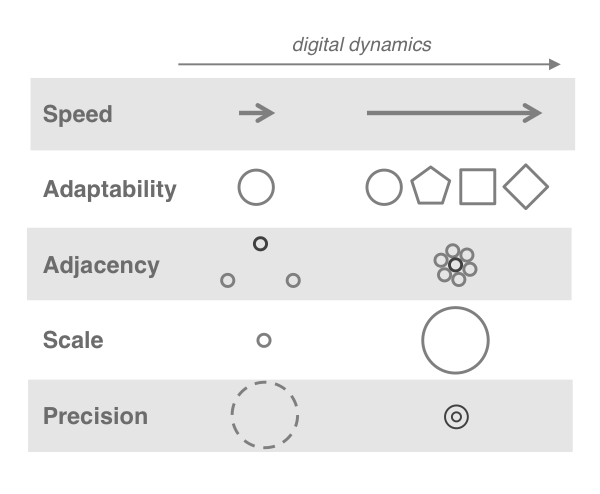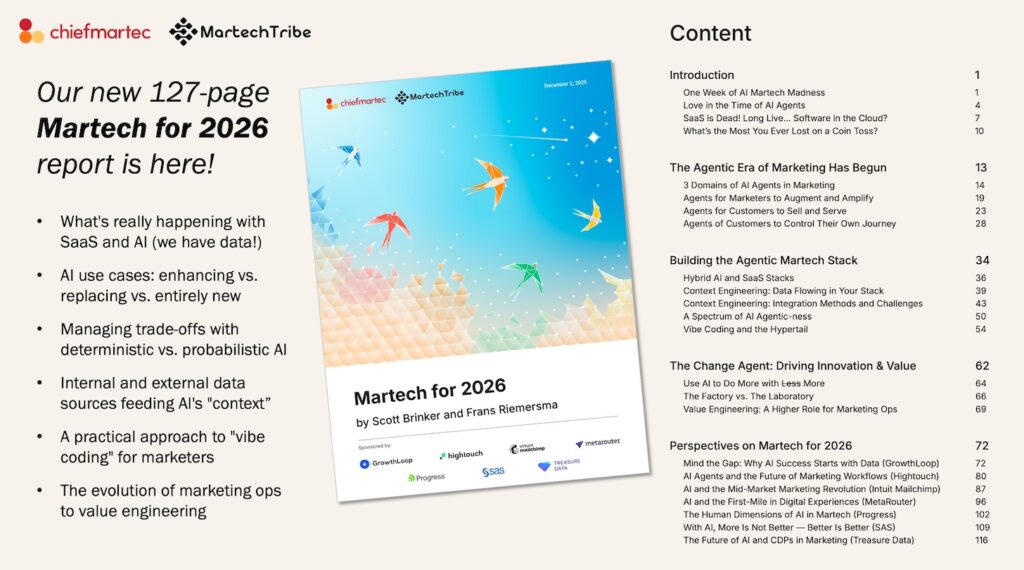As I prepare for the MarTech Europe conference coming up in a few weeks, I’ve been thinking about “digital transformation” — a topic that is entwined in the evolution of marketing, even though it’s much, much bigger than just marketing.
Digital transformation is about reimagining a business in the digital world. Or, if “reimagining” is too grand a vision, a more modest interpretation is simply: trying to survive in a digital world.
But while “digital” is a good one-word label for our modern world, there are several very different kinds of “digital dynamics” that are entangled together under that umbrella. As you contemplate changes in your strategy and your organizational structure to meet the digital challenge, I think it’s helpful to tease out the principal components of that whirlwind.
The model illustrated at the top of this post presents what I believe are the 5 components of digital dynamics: speed, adaptability, adjacency, scale, and precision. I call this the SAASP model accordingly because, well, as a technologist and a marketer, acronyms are my life.
SPEED: It’s astounding how fast the Internet moves. At the lowest level, there’s the wonder of being able to download things from systems halfway around the world in a matter of seconds, essentially for free. But on top of that ubiquitous network, new patterns of social interaction have sprouted that can spread news and ideas across a massive, distributed audience in a matter of hours, or even minutes. This has changed not just business communications, but the expectations of immediacy that people have of businesses — as well as the accelerating pace by which markets and competitive circumstances change. How fast do you move?
ADAPTABILITY: Perhaps the biggest miracle of digital is how easy it is to change content and code at asymptotically zero cost. The malleability of bits has no parallel in the physical world of atoms. Yet so many of our norms around strategy and management are rooted in the relatively inflexible constraints of that physical world. Pushing this further, software increasingly adapts decisions and experiences automatically across a massive number of combinatorial cases and touchpoints, using complex algorithms that eclipse our ability to understand their myriad of millisecond decisions. As humans, our two greatest challenges are (1) being willing to adapt ourselves and our organizations in response to such rapid change and (2) learning to thinking combinatorially about our products, services, and operations.
ADJACENCY: Thanks to Google and social media and, well, the very nature of hyperlinks on the web, your entire competitive landscape is always just a click away. Your competitive landscape is no longer just businesses that directly intersect with your geographic location, your primary distribution channel, or your narrow circle of rivals who always used to come up in sales calls. Now, entrepreneurs from all over the world compete for your customers’ attention. But more disruptive than globalization is the risk that competitors whoe are “adjacent” to your market can substitute for your solution from a completely different angle. Or you can do that to them, if you’re clever enough to intercept the digital journeys of their buyers with the right content and services at key decision points.
In addition to external adjacency, the digital world has also pushed us towards greater internal adjacency within our organizations as well: departments and hierarchical silos are being cross-connected and made more collaborative through the demands of a market that now expects much more coherence across the buyer’s journey.
SCALE: Things scale in the digital world in ways that defy conventional gravity. With a popular piece of content, your website can go from a few hundred visitors to millions overnight. But what makes scale unique from speed is the economics of this: digital distribution doesn’t require a linear increase in costs. Often, it’s somewhere between constant and logarithmic — O(1) ≥ n ≥ O(log n) — growth. We frequently see a Paradox of Scale, where smaller, agile teams or individuals have greater impact than organizations that are exponentially larger. Scale can shrink in an instant too, demanding a much more fluid response to the opening and closing of windows of opportunity.
PRECISION: Digital’s bounty is data. We’re under such a torrent of data now that the phrase “big data” has already become passé (next up “colassal data”). Much of this data is quantifiable, which is a blessing and a curse. Blessing: precise digital measurements can bring much greater rationality to decision-making, including software-powered, automated decision-making. This is re-orienting marketing to revenue instead of expense. Curse: such quantified data may be arbitrarily precise and may not accurately represent reality. Precision != Accuracy. See 14 rules for data-driven marketing for a list of other data caveats to consider. The age of data-driven management must develop greater finesse to use this power without self-inflicted injury.
I know that many others have tackled this subject over the past 20 years, and this SAASP model is merely an amalgamated derivation of hundreds of similar ideas. However, I couldn’t find an existing model that synthesized this quite the way I was picturing it, so I thought I’d sketch this out and run it by you.
What do you think? Are these the right components for a spectroscopic analysis of digital dynamics? Are there others?









Cool summary! Feels spot on.
(Shame about the acronym — PASSA? ASSPA? SPAAS? no…)
I wish I was going to be in London for your event. It will be fantastic.
Thanks, Doug! Sorry I’ll miss you in London — hopefully catch you the next time.
Yeah, there’s got to be a better acronym out there. Or maybe just no acronym. 🙂
Thanks a lot Scott. I love your posts, and your thinking. Always truly enlightening.
I am excited to be working in the business of agile marketing and more specifically real time data insights helping businesses to make the right decisions and increase ROI using automated software.
I wonder where you see the future of this space? The challenge i feel is a proliferation of data analytics websites. There are now 100’s-1,000’s!!!
The future is simultaneously bright and shrouded in mystery. Like seeing the glow of the sun through a foggy morning.
I don’t have much talent at prediction, but there are probably more data analytics websites on the road ahead.
Of course, it totally depends on what you call ‘digital’. Cut to the core and you could easily argue that consumer behaviours are the single biggest factor transforming marketing.
Such is (marketing) life 😉
I agree that consumer behaviors are the center of marketing — and really, that’s where the attention should be paid.
In my head, the digital dynamics above are at a level below the consumer. They are the dynamics wrought by the technology itself, which have empowered consumers in exponentially transformative ways.
As my good friend Mayur Gupta would surely hashtag, #HumanFirst. 🙂
Great clarification, Scott. Totally agree. And in the meantime marketers and communicators must struggle to separate human cause from effect. Good old Marshall McLuhan knew his digital onions 🙂
Scott,
Another great distillation of the complex to the simple. Remarkably hard to do, so thanks.
Allen
Thank you, Allen.
Hi Scott, a brilliant piece, once again. Two thoughts to add: Your article is titled ‘The 5 digital dynamics that are transforming marketing’ – I would argue these digital dynamics are transforming our whole economy and not limited to marketing alone. Second, the notion of ‘Trust’ as one of the key pillars. It is no longer possible for organisations of any size to hide – truth will come out. Those organisations that have a trusted relationship with customers will win over those that don’t. It is so easy for customers to share experiences that brands are being challenged by democracy. STAPSA?!
Thanks, Nigel.
I agree with you that this is much bigger than marketing. I find myself thinking about it in the context of marketing. But you’re absolutely right: digital dynamics are changing just about every facet of human society. It is a fascinating era of history to watch blossom before our eyes.
I also agree that one of the significant outcomes of these digital dynamics has been their effects on trust and transparency. I do think that digital dynamics are operating at a level below that — essentially just the raw forces of the technology itself. But impact on trust and transparency is a much more meaningful result.